| Jose Chavez y Chavez from
Wikipedia
Jose Chavez y Chavez (1851 – 1924) was an outlaw from
the U.S. state of New Mexico. He was said to be of Mexican-American and
Native American ancestry. Chavez y Chavez became an outlaw at a relatively
young age, when he joined Billy the Kid's group.
Biography
Chavez y Chavez joined Billy the Kid in his twenties,
having already committed a number of small robberies and other crimes,
Chavez y Chavez would prove useful to Billy the Kid's gang. Together with
Billy and the four other members of the gang, Chavez y Chavez engaged in
the Lincoln County War that lasted from 1878 to 1879.
Chavez y Chavez met Billy the Kid, Jim French, Fred Waite,
Charlie Bowdre, John Middleton, and Tom O'Folliard after he decided to
join the Tunstall-McSween group in their war against the Dolan group. Inside
the Tunstall-McSween group, another group was formed, to try to give the
Tunstall-McSween group an edge over the Dolans. The Lincoln County Regulators,
as they were known, were forty five gunfighters that included Jose Chavez
y Chavez. During some point of his tenure as a member of the Regulators,
Chavez y Chavez met Billy the Kid and his other friends, joining the group
thereafter. |
.
.
.
.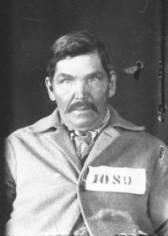 |
On February 18, 1878, John Tunstall was murdered. On April
1 of the same year, Lincoln's sheriff, a Dolan backer, was killed by the
Kid's gang, and Chavez y Chavez credited himself with this killing.
Eventually, more killings from both sides followed, leading
to the burning of the McSween home on July 19. Fourteen people lived at
the house, including McSween and his wife, as well as twelve cowboys. Six
people died in the fire, but every member of the Kid's gang was able to
escape.
By March 1879, New Mexico Governor Lew Wallace began a
fight against crime in that state, and one of his priorities was to stop
the ongoing war between the Dolans and the Tunstall-McSween backers. With
this in mind, Wallace formed the Lincoln County Mounted Rifles, a group
of which Chavez y Chavez became a member, as a private. The "Mounted Rifles"
failed in their purposes, however, and the group lasted only about three
months, a period during which Chavez y Chavez remained with Billy's gang.
Chavez y Chavez allegedly testified, alongside Billy the
Kid, in court to try to implicate the Army in connection to the burning
of the McSween house and subsequent deaths that occurred during the fires.
It is believed that, in 1880, Chavez y Chavez murdered a dangerous convict
in a New Mexico jail.
Jose Chavez y Chavez became adrift after Billy the Kid's
death, traveling across the American Southwest, sometimes without any particular
destination in mind. He did arrive at Las Vegas, New Mexico, in time to
meet Bob Ford, official killer of Jesse James. According to legend; the
two had agreed to a shooting game between them. So impressed was Ford with
Chavez y Chavez' gun abilities, that he fled immediately after he was asked
to have a duel against Chavez y Chavez.
Chavez y Chavez soon became a policeman. But he allegedly
was not able to leave his life as a desperado, becoming friends with Vicente
Silva and joining Silva's two gangs, including Las Gorras Blancas ("The
White Caps"), a group which was then linked by many Anglos as a bandit
group, and by most Native New Mexican Hispanos as freedom fighters. Silvas'
other group, "Bandits Society" was accused by recent Anglos immigrants
to New Mexico to have operated much like the mafia, trying to make profits
by forcing people out of their properties.
Vicente Silva ordered the killing of Patricio Maes, which
was carried out on October 22, 1892 by Chavez y Chavez, Eugenio Alarid
and Julian Trujillo. In February 1893, the group killed Silva's brother
in law, Gabriel Sandoval. However, Sandoval's death backfired on Silva,
when his wife became concerned about the whereabouts of her brother. When
Silva ordered Chavez y Chavez, Alarid and Trujillo to kill his wife, the
three gunmen became worried about Silva's mental state; they decided to
kill him as well when they were digging Silva's wife's grave, and so; Silva
and his wife were both murdered by Chavez y Chavez, Alarid and Trujillo
as Silva carried his wife to them.
In 1894, some men were arrested and brought to the courts
of law in connection with the killing of Patricio Maes. Chavez y Chavez
became a fugitive, but he was eventually arrested on May 26. A jury found
him guilty, and he was given the death sentence. A second trial came, and
Chavez y Chavez was again given a death sentence. This decision was later
overturned by a new Governor in New Mexico, who felt compelled to commute
Chavez y Chavez's sentence to life in prison instead, given the publicity
that this case garnered and the public's pressure towards the Government
to spare Chavez y Chavez' life at the time.
During a jail riot, Chavez y Chavez helped the police.
Subsequently, on January 11, 1909, New Mexico's Governor George Curry granted
him a pardon.
For the remaining fifteen years of his life, Chavez y
Chavez led a relatively quiet life, and he died of natural causes at his
home in 1924, with a friend by his side.
Popular culture
- In the 1988 movie, Young Guns, and its
1990 sequel, Young Guns II, Chavez y Chavez was portrayed by Lou Diamond
Phillips. In the
sequel, and
contrary to actual history, Chavez y Chavez dies as a result of a gunshot
wound from an encounter with Pat Garrett and
his hunting
party.
- Chavez y Chavez is also the name
of a character in the video game GUN.
|
Josiah Gordon "Doc" Scurlock from
Wikipedia
| Josiah Gordon "Doc" Scurlock (January 11, 1849 – July
25, 1929) was an American Old West figure, cowboy and gunfighter. A founding
member of the Regulators during the Lincoln County War in New Mexico, Scurlock
rode alongside such men as Billy the Kid.
Early life
He was born in Tallapoosa County, Alabama, the sixth of
11 children born to Priestly Norman Scurlock (July 3, 1806 – June 22, 1876)
and Esther Ann Brown (May 19, 1819 – June 1, 1903). Josiah was said to
have studied medicine in New Orleans, thus receiving his nickname "Doc".
Described as 5 feet 8 inches (1.73 m) tall, weighing 150
pounds (68 kg), with brown eyes and dark blond hair, Doc went to Mexico
in about 1870. While there, he and another man had an argument over a card
game and drew their pistols. The other man shot first and the bullet went
through Doc's mouth, knocking out his front teeth and coming out the back
of his neck without any more serious damage. He quickly returned fire and
killed the man who shot him.
Cowboy and bounty hunter
Scurlock returned to the United States in 1871 and went
to work as a line rider for John Chisum. He and other riders were also
used to defend Chisum and his cattle holdings in the event cattle rustlers
attempted to prey on them. Sometime during 1873, he and Jack Holt were
surprised by a group of Indians and Holt was killed. Scurlock found refuge
among some rocks and, after a protracted fight, he killed the Indian leader.
During the night he slipped away and walked 20 miles (32.1 km) for help.
At some time after the fight, Holt's body was presumably partially dismembered,
as its right arm was removed at the elbow.
In September 1875, Scurlock's riding partner, Newt Higgins,
was killed by Indians. Scurlock was so upset over this incident he told
Chisum he wanted to quit. Chisum, however, would not hear of it and refused
to pay him. Scurlock then made the newspapers when he stole three horses,
two saddles, and a rifle and left for Arizona. Chisum sent some of his
men after Scurlock and they caught up with him, but when he explained that
he took the things because Chisum would not pay him, they agreed with him
and let him go. |
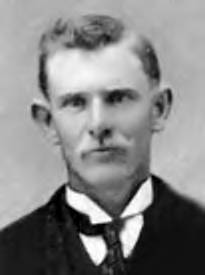
Doc Scurlock in a formal picture.
Taken during or just after
Lincoln County War
Historical Fair Use Of Photograph {PD-US}
| Born |
January 11, 1849
Tallapoosa County, Alabama, USA |
| Died |
July 25, 1929 (aged 80)
Eastland, Texas, USA |
| Resting place |
Eastland City Cemetery |
| Occupation |
Gunman, outlaw, cowboy, vigilante, bounty hunter |
| Known for |
Lincoln County Regulators |
|
In Arizona, he met Charlie Bowdre and the two men opened
a cheese factory on the Gila River. Some of Scurlock and Bowdre's descendants
have said that one of their first employees was Billy the Kid. After they
closed the cheese factory in the spring of 1876, Scurlock and his best
friend, Bowdre, returned to Lincoln County, New Mexico, where they bought
a ranch on public domain land on the Rio Ruidoso from L. G. Murphy on credit,
which made them victims of the L. G. Murphy & Co. monopoly.
Scurlock, Bowdre, Frank Coe, George Coe and Ab Saunders
stormed the very weak Lincoln jail on July 18, 1876, freeing cattle rustler
Jesus Largo from the custody of Sheriff Saturnino Baca. They took Largo
outside of town and hanged him. Scurlock accidentally shot and killed his
friend, Mike G. Harkins, manager of John H. Riley's store at Blazer's Mill,
while he was examining a pistol on September 2, 1876.
On October 19, 1876, Scurlock and María Antonia
Miguela Herrera (June 13, 1860-November 27, 1912) were married in Lincoln,
New Mexico. (Around the same time, Antonia's sister, Manuela Herrera, married
Charlie Bowdre, which made Bowdre a brother-in-law of Scurlock.) Ten children
were eventually born of Scurlock and Antonia's union.
Lincoln County War
For over a year, Scurlock was in several posses to pursue
and arrest horse thieves. He, Bowdre and others lynched some of the thieves
they caught. In January 1877, Scurlock and a neighbor, George Coe, were
arrested by Sheriff William J. Brady for suspicion of harboring a murdering
fugitive and member of the Jesse Evans Gang named Frank Freeman. For the
next few days, Scurlock and Coe received very harsh treatment from Brady.
They were allegedly tortured, but were eventually released. In October
1877, the Evans Gang stole horses belonging to John Tunstall, Alexander
McSween and Richard "Dick" Brewer from Brewer's Rio Ruidoso ranch. Scurlock
and Bowdre, as well as Brewer, went off in pursuit of the Evans Gang and
located them, but were unable to regain possession of the stolen horses.
After Tunstall was murdered in February 1878, Scurlock
became a founding member of the Regulators and was involved in most of
the battles of the Lincoln County War. In the Gunfight of Blazer's Mills
on April 4, Scurlock was shot in the leg by Buckshot Roberts. Scurlock
later became the third and final leader of the Regulators, after prior
leaders Dick Brewer and Frank McNab had been killed.
Scurlock served as a deputy sheriff under Sheriff John
Copeland, who was a McSween partisan and replaced Sheriff Brady. On May
14, 1878, he led a posse of 18 to 20 men, which included Billy the Kid,
Bowdre, George Coe, Brown, and Scroggins, to the Dolan-Riley cattle ranch,
ostensibly in search of those implicated in the killing of MacNab and the
wounding of Saunders. According to Riley, they drove off 26 horses and
two mules, killed a herder named Wair, a Navajo Indian employed at the
ranch as a cook and a 15-year-old boy called Johnny. However, W.T. Thornton,
Thomas B. Catron's law partner, reported that the latter two were only
wounded.
Since Catron had foreclosed on the property of J. J. Dolan
& Co., the horses appear to have been his property. As a result of
his strong protest to the governor, Copeland was removed as sheriff due
to his refusing to side with the Murphy-Dolan faction. The raid by the
Regulators resulted in the removal of one of their partisans from a position
of authority and his replacement with George Peppin, who was just as strongly
attached to the other side.
| Later life
In about October or November 1879, Scurlock moved to Texas,
where he settled down and became a highly respected citizen. On the 1880
census in Potter County, Texas, he was keeping the mail station.
Doc Scurlock died at age 80 from a heart attack in Eastland,
Texas. He is interred in Eastland City Cemetery, along with his wife and
other family members.
Movie portrayals
In the western film, Young Guns, Scurlock was portrayed
by actor Kiefer Sutherland, as a polite, moral, poetry writing cowboy.
At the end of the film, Scurlock left Billy the Kid's posse, fleeing from
New Mexico with an Asian woman he fell for earlier in the movie in the
hopes of starting a new life in the East.
In the sequel, Young Guns II, Scurlock (again played by
Sutherland) is serving as a school teacher in New York City when he is
arrested and taken back to New Mexico, where he is saved from hanging by |
.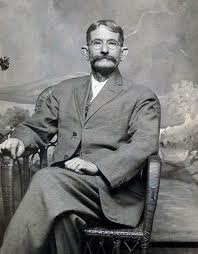 |
The Kid. He rejoins Billy's posse and is mortally wounded
by John W. Poe, played by Viggo Mortensen, and then killed in a barrage
of bullets, though the ambush was led by Pat Garrett. This is inaccurate,
as Scurlock was married to a Spanish woman in 1876 and died peacefully
in Texas many years after the period of time covered by the movie.
The original "Young Guns II" screenplay accurately portrays
Scurlock as heading off to Texas with his bride. It has been reported that
Kiefer Sutherland, faced with scheduling conflicts, refused to return to
the Young Guns franchise unless his character died in the movie's "Stinking
Springs Shoot Out". Writer John Fusco fought against this demand, but ultimately
rewrote the scene to accommodate Sutherland's schedule.
|
Dave Rudabaugh from Wikipedia
| David Rudabaugh (July 14, 1854 – February 18, 1886),
was an outlaw and gunfighter in the American Old West. Modern writers often
refer to him as "Dirty Dave" on account of his alleged aversion to water,
no evidence has emerged to show that he was ever referred to as such in
his own lifetime.
Early life
Rudabaugh was born as David Rodenbaugh in Fulton County,
Illinois. His father was killed in the Civil War when Dave was a boy. The
family moved around following this, spending time in Illinois, Ohio, and
Kansas. |
| Born |
David Rodenbaugh
July 14, 1854
Fulton County, Illinois, USA |
| Died |
February 18, 1886 (aged 31)
Parral, Chihuahua, Mexico |
| Occupation |
Cattle Rustler
Train/Stagecoach Robber
Cowboy |
| Years active |
1870s-1886 |
|
Outlaw
The outlaw career of Dave Rudabaugh began in earnest in
Arkansas in the early 1870s. He was part of a band of outlaws who robbed
and participated in cattle rustling along with Milton Yarberry and Mysterious
Dave Mather. The three were suspected in the death of a rancher and fled
the state. By some accounts all three went to Decatur, Texas, but other
accounts have Rudabaugh heading to the Black Hills of South Dakota, where
he became a stagecoach robber.
The Trio
Sometime around 1876, Rudabaugh joined Mike Roarke and
Dan Dement to form the outlaw band known as the "Trio." There is a disputed
story from around this time that Rudabaugh taught Doc Holliday to use a
pistol while Doc taught him the finer points of playing cards.
In 1877, Wyatt Earp was tracking the Trio from Dodge City
to Fort Griffin, Texas, in the hope of arresting them. He never caught
up with them but befriended Doc Holliday and Big Nose Kate while in Fort
Griffin. The Trio eluded capture and built up their gang to six members,
which
was then known as the Rudabaugh-Roarke Gang, and set about attempting to
rob trains.
Capture and release
Rudabaugh's gang made their first attempt on a train on
January 22, 1878, near Kinsley, Kansas. The robbery was a failure, and
the gang came away with no loot. The next day, a posse led by Bat Masterson,
including John Joshua Webb, captured Rudabaugh and fellow gang member Ed
West. The rest of the gang was captured shortly after. Rudabaugh struck
a deal for immunity with the prosecutor and testified against his partners.
Shortly following his release, Rudabaugh accepted Masterson's
offer to join a group of gunfighters to fight for the Atchison, Topeka
and Santa Fe Railway in the Railroad Wars.
Dodge City Gang
During this time he became a close associate of John Joshua
Webb, whom he had met during his earlier arrest. After the railroad wars,
he and Webb traveled to the town of Las Vegas, New Mexico, where they became
important members of the Dodge City Gang. This gang was a band of ruffians
and gamblers who were dominating the political and economic life of the
growing community. The leader was Hyman G. Neill (aka Hoodoo Brown). Webb
was arrested for murder in the spring of 1880. Dave Rudabaugh and another
gang member attempted to break him out of jail on April 5, 1880. The attempt
failed, and Rudabaugh shot and killed deputy Antonio Lino Valdez in the
process.
The Rustlers and capture
He fled to Fort Sumner, New Mexico, where he eventually
joined the gang led by Billy the Kid.
At Stinking Springs (near present-day Taiban, New Mexico),
On December 23, 1880 a posse led by Pat Garrett captured Rudabaugh, Billy
the Kid, Billy Wilson, and other members of the gang. They were taken to
Las Vegas, but the danger of a lynch mob prompted the officers to move
them to Santa Fe. In February 1881,while in court, Rudabaugh pleaded guilty
and was sentenced to 99 years in prison for several counts of mail robbery.
He was then found guilty for the murder of Las Vegas deputy Lino Valdez
and was sentenced to death by hanging.
Imprisonment and escape
Rudabaugh was reunited with Webb in jail. After a botched
escape attempt in which a fellow prisoner named Thomas Duffy died, he and
Webb broke out. Rudabaugh fled to Arizona where he joined the Clanton faction
in their feud against the Earps. Dave may have even participated in the
murder of Morgan Earp and the attempted murder of Virgil Earp, and may
also have been present at the gunfight at Iron Springs in which Curly Bill
Brocius was killed.
Death
As the Clanton gang broke up, Rudabaugh headed down to
Mexico where he worked as both a cowboy and a rustler. On February 18,
1886, Rudabaugh was involved in a gunfight with locals in Parral, Chihuahua.
The fight began over a card game. He drew his pistol and killed two men
and wounded another. He left the saloon unharmed, but unable to find his
horse, he re-entered a few moments later, which turned out to be a fatal
mistake. He was shot several times from the shadows, then was decapitated
with a machete and his head placed on a pole.
Other information
- Dave Rudabaugh was the only outlaw
said to have crossed paths with Dave Mather, Bat Masterson, Pat Garrett,
Wyatt Earp,
Billy The
Kid and Doc Holliday.
- Dave lived to be 31 years, 7 months
and 4 days old.
- Dave's decapitated head was placed
on a stake for almost three weeks after his death.
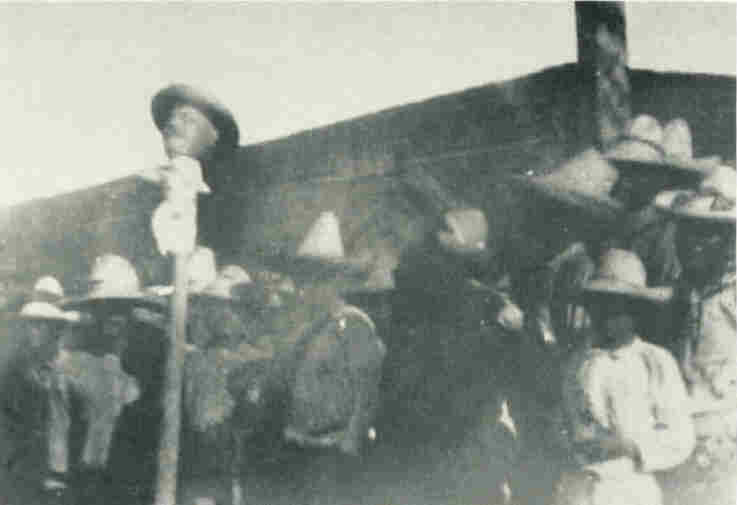
. |
Charlie Bowdre from Wikipedia
Charles Bowdre (1848 – December 23, 1880) was an American
cowboy and outlaw. He was an associate and member of Billy the Kid's gang.
Early life
Bowdre was born in Wilkes County, Georgia. When he was
three years old, he and his parents moved to Mississippi. By 1854, young
Charlie started working in his father's farm, and as he grew up became
an adept farmer. Much of what Bowdre did between the year in which his
last sister was born (1863) and 1874, remains a mystery.
It is believed, however, that he abandoned the family's
farm to become a wanderer. Records show that by 1874, he had arrived at
Lincoln County, New Mexico. Bowdre became friends with Doc Scurlock during
this time, and the two men opened a cheese factory on the Gila River. He
also joined Scurlock on several posses during this period, pursuing cattle
thieves and rustlers, on several occasions taking part in the lynching
of those captured. On July 18, 1876, Bowdre, Scurlock, Frank Coe, George
Coe, and Ab Saunders storm the very weak Lincoln jail, freeing cattle rustler
Jesus Largo from the custody of Sheriff Saturnino Baca, taking Largo outside
of town and hanging him. No charges were ever filed for the event. On August
5, 1877, he and a companion were arrested for "shooting up" the town of
Lincoln while intoxicated. |
.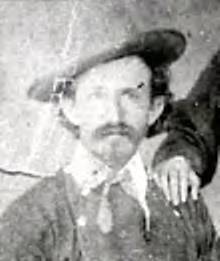
Charlie Bowdre. |
Lincoln County War
With the outbreak of the Lincoln County War in 1878, Bowdre
sided with the Tunstall-McSween side, and he met Billy, Jose Chavez y Chavez
and the rest of the Kid's associates, including Richard M. Brewer and Jim
French, George Coe and Frank Coe. During the conflict, he was known to
have been present with his fellow Regulators when William Morton, Frank
Baker, and William McCloskey were killed along the Blackwater Creek on
March 9, 1878. Bowdre was shot by Buckshot Roberts during the Gunfight
of Blazer's Mills on April 4, 1878, and in turn shot Roberts. It was never
confirmed as to whether Bowdre's shot eventually killed Roberts, or a shot
fired by George Coe killed him. Bowdre would be charged with killing Buckshot
Roberts during the Blazer's Mills Gunfight, and was present in the July
15 through July 19, 1878 Battle of Lincoln.
After the Lincoln County War
Bowdre worked as a cowboy on the ranches of Thomas Yerby
and Pete Maxwell as the war went on, as well as being an active participant.
Bowdre married a twenty five-year-old Mexican girl, Manuela, some months
before his death. Manuela was a sister to Doc Scurlock's wife, Antonia.
The fact that he was recently married when he died makes him less likely
to have been involved in the gang's activities during the few weeks that
passed between his marriage and his death.
By December 1880, Charlie Bowdre was ready to quit riding
with Billy the Kid and surrender for the murder of Buckshot Roberts, but
he still joined the rest of the gang on a mission to ambush Pat Garrett
in Fort Sumner. A gun battle ensued, but Bowdre and most of the Kid's gang
members escaped alive. On December 23, however, the gang was holed up in
a rock house at Stinking Springs. At dawn, Charlie Bowdre emerged to feed
the horses and was riddled with rifle slugs by Garrett's posse, which had
surrounded the building in the night. Later that day, Billy the Kid and
his partners gave up.
His remains were returned to his wife, and he was interred
next to Tom O'Folliard, another member of Billy's gang. In 1962, a relative
named Louis Bowdre was found, and a court tried to have Bowdre's remains
removed. But the relative disagreed, saying that Bowdre would prefer to
rest next to O'Folliard.
Other media
Charlie Bowdre was played by Charles Martin Smith in Sam
Peckinpah's Pat Garrett & Billy the Kid (1973). Later, in the 1988
film Young Guns, he is portrayed by actor Casey Siemaszko.
|
.
All articles submitted to the "Brimstone
Gazette" are the property of the author, used with their expressed permission.
The Brimstone Pistoleros are not
responsible for any accidents which may occur from use of loading
data, firearms information, or recommendations published on the Brimstone
Pistoleros web site. |
|